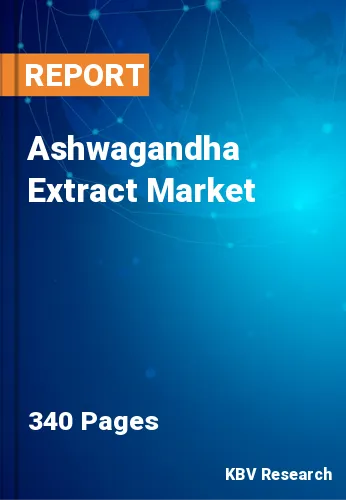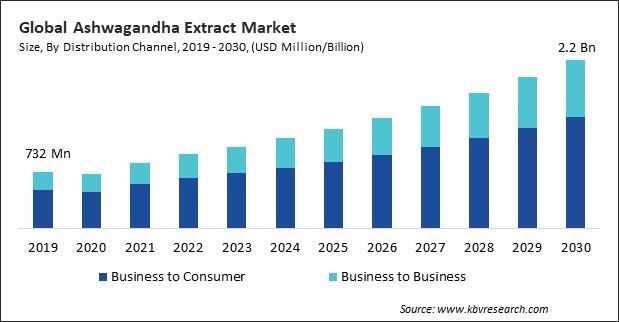
The Global Ashwagandha Extract Market size is expected to reach $2.2 billion by 2030, rising at a market growth of 10.9% CAGR during the forecast period. In the year 2022, the market attained a volume of 61,767.85 thousand units, experiencing a growth of 11.1% (2019-2022).
In the Asia Pacific region, where Ayurveda is deeply rooted, ashwagandha extract is valued for its therapeutic properties and is incorporated into various traditional remedies and formulations. Consequently, the Asia Pacific region captured $456.15 million in the market in 2022. Also, the India market consumed 4,740.96 thousand units in 2022. Ashwagandha is culturally familiar to many people in the Asia Pacific region, where traditional herbal remedies are often preferred over pharmaceutical interventions.

Many consumers are adopting plant-based diets for health, environmental, and ethical reasons. Ashwagandha extract, derived from the roots of the Withania somnifera plant, fits well within plant-based dietary patterns, making it an attractive choice for individuals following vegan or vegetarian lifestyles. It is rich in bioactive compounds, including alkaloids, steroidal lactones (withanolides), and flavonoids, which are believed to offer various health benefits. Thus, because of the increasing popularity of plant-based diets, the market is anticipated to increase significantly.
Additionally, E-commerce platforms make its products accessible to consumers, regardless of location. As per the International Trade Administration, global e-commerce sales for B2B businesses have gradually increased over the last decade, with the global B2B e-commerce industry expected to be worth USD$36 trillion by 2026. Hence, rapid shift toward e-commerce platforms has been a pivotal factor in driving the growth of the market.
However, Regulatory frameworks governing dietary supplements, including ashwagandha extract, often involve complex compliance requirements related to product formulation, labeling, advertising, and safety standards. Navigating these rules may be time-consuming and costly for manufacturers, mainly small and medium-sized enterprises, resulting in delayed product launches and increased operational costs. Thus, regulatory challenges can slow down the growth of the market.
 Drivers
Drivers  Restraints
Restraints  Opportunities
Opportunities  Challenges
Challenges By application, the market is categorized into sports nutrition, food & beverages, dietary supplements, and others. The dietary supplements segment covered the 40.58% revenue share in the market in 2022. In terms of volume, dietary supplements segment utilized 25,576.71 thousand units in 2022. Food Processing Industries estimates that the Indian dietary supplement industry will be worth USD 3924.44 million in 2020 and USD 10,198.57 million by 2026, representing a 22% annual growth rate.

Based on distribution channel, the market is classified into business to business and business to consumer. The business to consumer segment acquired the 67.45% revenue share in the market in 2022. In terms of volume, business to consumer segment registered 1,01,064.55 thousand units in 2022. Business to consumer (B2C) marketing efforts, including advertising, social media campaigns, and educational content, are crucial in growing awareness about the health benefits of ashwagandha extract.
On the basis of form, the market is divided into powder, capsules/tablets, and others. The powder segment garnered a 31.28% revenue share in the market in 2022. In terms of volume, powder segment consumed 11,567.41 thousand units of Powder (Pack of 1 KG) in 2022. Its powder offers versatility in consumption. It can be easily incorporated into numerous formulations, such as smoothies, beverages, protein shakes, and recipes. This versatility appeals to consumers seeking convenient ways to incorporate ashwagandha into their daily routines.
Free Valuable Insights: Global Ashwagandha Extract Market size to reach USD 2.2 Billion by 2030
Region-wise, the market is analysed across North America, Europe, Asia Pacific, and LAMEA. In 2022, the North America region acquired a 25.20% revenue share in the market. In terms of volume, North America region would consume 37,780.91 thousand units in 2022. The availability of the products has increased in North America, with a wide range of supplements, beverages, and functional foods incorporating ashwagandha extract hitting the market.
| Report Attribute | Details |
|---|---|
| Market size value in 2022 | USD 964.20 Million |
| Market size forecast in 2030 | USD 2.2 Billion |
| Base Year | 2022 |
| Historical Period | 2019 to 2021 |
| Forecast Period | 2023 to 2030 |
| Revenue Growth Rate | CAGR of 10.9% from 2023 to 2030 |
| Quantitative Data | Volume in Thousand Units, Revenue in USD Billion, and CAGR from 2019 to 2030 |
| Number of Pages | 340 |
| Number of Tables | 690 |
| Report coverage | Market Trends, Revenue Estimation and Forecast, Segmentation Analysis, Regional and Country Breakdown, Porter’s 5 Forces Analysis, Company Profiling, Companies Strategic Developments, SWOT Analysis, Winning Imperatives |
| Segments covered | Form, Distribution Channel, Application, Region |
| Country scope |
|
| Companies Included | Kerry Group PLC, Dabur India Ltd., Emami Limited, The Procter and Gamble Company, Patanjali Ayurved Limited, Himalaya Wellness Company (Himalaya Global Holdings Ltd.), Shree Baidyanath Ayurved Bhawan Pvt. Ltd., Unilever PLC, Taos Herb Company, Kairali Ayurvedic Group |
By Distribution Channel (Volume, Thousand Units, USD Billion, 2019-2030)
By Form (Volume, Thousand Units, USD Billion, 2019-2030)
By Application (Volume, Thousand Units, USD Billion, 2019-2030)
By Geography (Volume, Thousand Units, USD Billion, 2019-2030)
The Market size is projected to reach USD $2.2 billion by 2030.
Rapid shift toward e-commerce platforms are driving the Market in coming years, however, Lack of supply chain vulnerabilities restraints the growth of the Market.
Kerry Group PLC, Dabur India Ltd., Emami Limited, The Procter and Gamble Company, Patanjali Ayurved Limited, Himalaya Wellness Company (Himalaya Global Holdings Ltd.), Shree Baidyanath Ayurved Bhawan Pvt. Ltd., Unilever PLC, Taos Herb Company, Kairali Ayurvedic Group
In the year 2022, the market attained a volume of 61,767.85 thousand units, experiencing a growth of 11.1% (2019-2022).
The Capsules/Tablets segment is leading the Market by Form in 2022; thereby, achieving a market value of $1.0 Billion by 2030.
The Asia Pacific region dominated the Market by Region in 2022, and would continue to be a dominant market till 2030; thereby, achieving a market value of $1.0 Billion by 2030.
Our team of dedicated experts can provide you with attractive expansion opportunities for your business.
